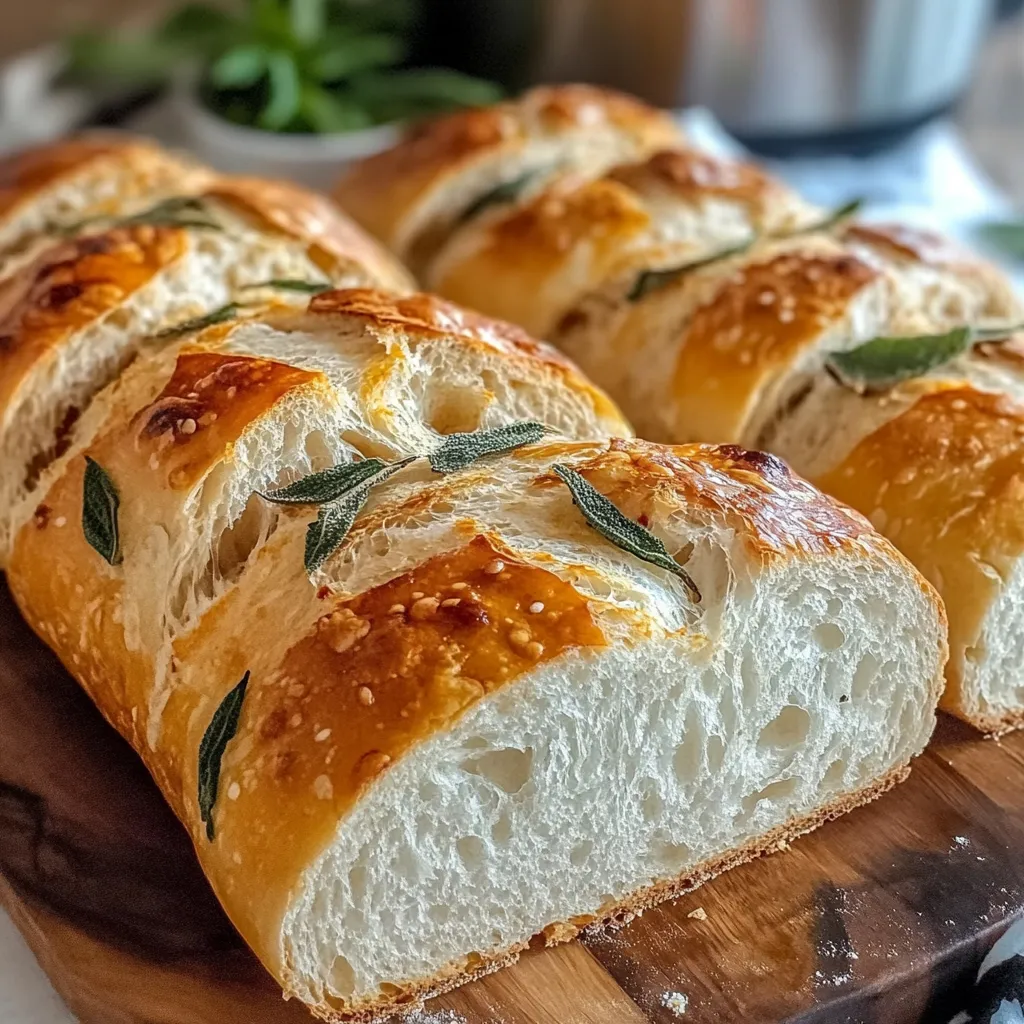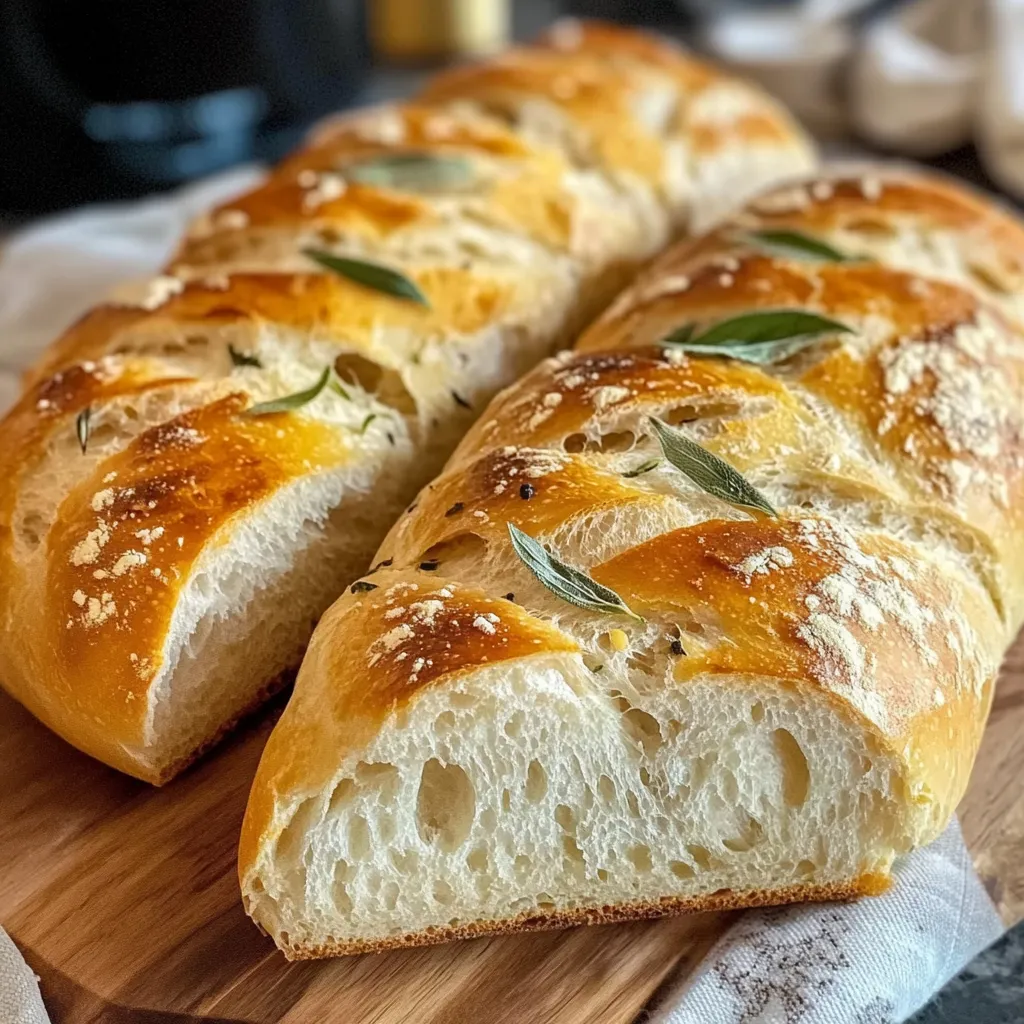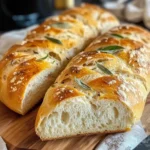Crusty Italian Bread Recipe: Easy Homemade Delight

There’s nothing quite like the comforting aroma of freshly baked bread wafting through your kitchen. This Crusty Italian Bread Recipe: Easy Homemade Delight showcases the perfect balance of a crispy exterior and a soft, chewy interior that is sure to elevate any meal. Not only is this recipe straightforward, but it also invites a world of creativity—experiment with aromatic herbs like rosemary or thyme, or incorporate roasted garlic for an extra flavor punch.
To ensure that your bread achieves that coveted crusty finish, a few key tips can make all the difference. Consider using a baking stone to replicate the hot oven conditions of traditional Italian bakeries, or a steam-injected oven setup for a bakery-quality crust! Whether enjoyed with a generous smear of butter, dipped into olive oil, or transformed into delicious garlic bread, this easy homemade loaf is more than just a staple; it’s a canvas for countless flavor possibilities that will impress family and friends alike. Happy baking!
Ingredients for Crusty Italian Bread Recipe: Easy Homemade Delight:
To craft the perfect Crusty Italian Bread, you will need high-quality ingredients that come together harmoniously. Below is a list of all the essentials you’ll need, along with some optional variations to elevate your homemade loaf.
Bread Ingredients
- 4 cups (500g) all-purpose flour: Ensure that it’s unbleached for a better rise and flavor.
- 1 ½ cups (360ml) warm water (about 110°F / 43°C): This temperature helps activate the yeast effectively.
- 2 teaspoons (7g) active dry yeast: Fresh yeast is key to achieving that lovely rise.
- 2 teaspoons (10g) sea salt: For enhanced flavor and crust texture.
- 1 tablespoon (15ml) olive oil: Adds richness to the dough and helps in browning the crust.
Optional Flavor Enhancements
- 1 tablespoon (15g) honey or sugar: Adding a touch of sweetness can enhance the flavor profile.
- 1 tablespoon (15g) dried herbs: Consider rosemary or oregano for an aromatic twist.
- 1 tablespoon (15ml) balsamic vinegar: A splash of acidity that can create depth in flavor.
- ½ cup (50g) grated Parmigiano-Reggiano cheese: For a cheesy crust, incorporate this during kneading.
Equipment You Might Need
- Large mixing bowl: For dough gathering and mixing ingredients.
- Wooden spoon or dough scraper: Perfect for mixing dry and wet ingredients.
- Kitchen towel: To cover the dough during rising and prevent drying out.
- Baking stone or sheet: Optimal for achieving a crispy crust.
- Sharp knife or lame: For scoring the dough before baking, allowing it to expand properly.
The additional ingredients mentioned in the optional section can greatly enhance the traditional profile of your Crusty Italian Bread, providing depth and a personal touch to the classic recipe. Feel free to experiment with various herbs and spices to transform your loaf into a gourmet delight!

How to prepare Crusty Italian Bread Recipe: Easy Homemade Delight:
Follow these detailed steps to master your Crusty Italian Bread. From mixing the ingredients to enjoying your fresh loaf, each step is crucial for success.
Step 1: Gather Your Ingredients
Start by assembling all necessary ingredients. You will need 4 cups of all-purpose flour, 2 teaspoons of salt, 1 teaspoon of sugar, 1 packet (or 2 ¼ teaspoons) of active dry yeast, and 1 ½ cups of warm water. Ensure the water is about 110°F (43°C) to activate the yeast properly.
Step 2: Activate the Yeast
In a small bowl, combine the warm water, sugar, and yeast. Stir gently and let it sit for about 5 to 10 minutes until it becomes frothy. This indicates that the yeast is active and ready to work.
Step 3: Mix Dry Ingredients
In a large mixing bowl, combine the flour and salt. Use a whisk to evenly distribute the salt throughout the flour, ensuring balanced flavor and texture in your bread.
Step 4: Combine Wet and Dry Mixtures
Make a well in the center of the dry mixture. Pour the activated yeast mixture into this well. Stir with a wooden spoon or spatula until a rough dough forms. The mixture may seem sticky; that’s perfect.
Step 5: Knead the Dough
Transfer the dough onto a lightly floured surface. Knead the dough for about 10 minutes. Aim for a smooth and elastic texture. If the dough sticks too much, sprinkle a little more flour as needed.
Step 6: Allow Dough to Rise
Shape the kneaded dough into a ball and place it in a lightly greased bowl. Cover it with a clean kitchen towel. Let it rise in a warm place for 1 to 2 hours, or until it doubles in size. Be patient; this step develops the flavor.
Step 7: Shape the Loaf
After rising, gently punch down the dough to release gas bubbles. Turn it out onto a floured surface and shape it into a loaf. Place the shaped dough on a parchment-lined baking sheet or in a loaf pan.
Step 8: Final Proofing
Cover the shaped loaf with a towel. Let it rise for another 30 minutes. This final proofing time allows your bread to achieve a great texture.
Step 9: Preheat the Oven
While your dough is rising, preheat the oven to 450°F (232°C). This high heat is crucial for creating a crusty exterior.
Step 10: Bake the Bread
Once the oven is hot, make a few shallow slashes on the top of the loaf with a sharp knife. This allows steam to escape while baking. Place the loaf in the oven and bake for 25-30 minutes, until it turns golden brown.
Step 11: Cool and Enjoy
Remove the bread from the oven and let it cool on a wire rack. Once cooled, slice and savor your homemade crusty Italian bread! Enjoy with olive oil, butter, or your favorite spreads!
Tips for the Perfect Crusty Italian Bread Recipe: Easy Homemade Delight
Maintaining the Right Temperature
To achieve that much-desired crusty exterior, it’s crucial to maintain the correct temperature during both the mixing and baking stages. Use warm water (around 110°F or 43°C) to activate the yeast effectively. If the water is too hot, it can kill the yeast, while cold water will do the opposite. Allow your dough to rise in a draft-free area. An oven with just the light on can create an ideal environment for proofing.
Using Quality Ingredients
The success of your bread hinges on the quality of your ingredients. Opt for high-protein bread flour instead of all-purpose flour to achieve better structure and chewiness. Fresh yeast is ideal, but if unavailable, active dry yeast works perfectly well. Always check the expiration dates for your yeast and flour to ensure freshness. Salt plays a vital role in flavor and should be of good quality, preferably sea salt or kosher salt.
Substitutions for Dietary Restrictions
Making this crusty bread can be adjusted for various dietary needs without sacrificing flavor. For gluten-free options, many specialty flours are available. Use a gluten-free all-purpose blend, but follow the manufacturer’s instructions for rising times and hydration levels. If you want a vegan version, replace any dairy or egg elements with plant-based alternatives. Use almond milk or oat milk instead of dairy for added moisture and flavor.
Enhancing Flavor and Texture
Consider adding herbs like rosemary or thyme into the dough for extra depth of flavor. You could also mix in seeds, such as sesame or poppy, before baking to give your loaf an attractive finish. A combination of cold water and steam in your oven during the first few minutes of baking can develop a crustier texture. Place a pan filled with hot water on the oven’s lower rack while baking to create steam. This technique mimics traditional baking methods used in Italian bread-making.
Storing and Using Leftovers
To keep your crusty Italian bread fresh, wrap it in a clean kitchen towel and store it at room temperature. Avoid plastic bags, as they can soften the crust. If you have leftovers, the bread can be toasted or repurposed into croutons. Simply cube the stale bread, toss it with olive oil and seasonings, and bake until crispy.
By keeping these tips in mind, you’ll find baking a perfect crusty Italian bread is not only achievable but also rewarding.
Storage Tips for Crusty Italian Bread Recipe: Easy Homemade Delight:
Storing your homemade Crusty Italian Bread properly helps maintain its freshness and flavor. With a few smart choices, you can enjoy your bread for days. Here are some effective storage tips:
Keep It Cool
Always allow your bread to cool completely before storing. Warm bread can create humidity, leading to sogginess. Once cooled, wrap the bread in a clean cotton or linen cloth. This wrap helps absorb excess moisture and promotes air circulation. Avoid plastic wrap, as it can trap moisture and cause the crust to become soft.
Optimal Storage Conditions
Store your wrapped bread in a breadbox or on a cool countertop. Keep it away from direct sunlight and heat sources. A breadbox maintains a stable environment, reducing exposure to air and light. If you do not have a breadbox, any dry, dark place in your kitchen will do. Remember, too much humidity can contribute to mold growth, while excessive dryness can cause the crust to harden.
Refrigeration: A No-Go
Avoid putting your Crusty Italian Bread in the refrigerator. While refrigeration might seem like a way to prolong shelf life, it can actually speed up the staling process. Bread stored in the fridge can lose its flavor and texture, making it less enjoyable.
Freezing for Longevity
If you want to store your bread for a more extended period, freezing is an excellent option. Slice the bread before freezing. This method allows you to take out only what you need. Wrap each slice individually in plastic wrap or aluminum foil, then place them in an airtight freezer bag. When ready to eat, thaw the slices at room temperature or toast them directly from the freezer.
Understanding Shelf Life
When stored correctly, your Crusty Italian Bread should stay fresh for about 2 to 3 days at room temperature. For longer storage, freezing can keep it good for up to 3 months. Always check for signs of spoilage before consuming, such as unusual odors or mold.
Following these storage tips, you can enjoy your Easy Homemade Delight longer while keeping its delicious crust and flavor intact. Happy baking!
Related Recipes to Enhance Your Baking Experience
If you loved making the Crusty Italian Bread Recipe: Easy Homemade Delight, you might enjoy exploring these complementary recipes. Each dish highlights similar techniques and flavors, enriching your culinary journey.
- Garlic Herb Focaccia: This fluffy Italian bread is infused with garlic and fresh herbs. Like the crusty Italian bread, it uses a simple dough but adds aromatic oils that elevate the taste profile. The airy texture paired with a crispy crust makes focaccia a wonderful addition to any meal, especially when paired with soups or salads.
- Cinnamon Raisin Bread: This sweet bread showcases the versatile use of yeast, similar to the crusty Italian bread. The delightful flavor combination of cinnamon and raisins brings a sweet contrast. It’s perfect for breakfast or a midday snack, offering a lovely way to enjoy homemade bread in a different format.
- Classic Bruschetta: While not a bread recipe, bruschetta complements your homemade crusty bread beautifully. Topped with fresh tomatoes, basil, and olive oil, it serves as a delicious appetizer. The toast-like texture of the crusty bread offers the perfect base for these vibrant toppings.
- Ciabatta Rolls: These rolls are another Italian specialty featuring a chewy texture and open crumb structure. They are fantastic for sandwiches or as a side for meals. Crafting ciabatta allows you to experiment with hydration levels in dough, much like the Crusty Italian Bread Recipe: Easy Homemade Delight.
These recipes not only share common ingredients but also allow you to hone your baking skills while experimenting with flavors and textures. Enjoy baking them alongside your crusty Italian bread for a well-rounded culinary delight!
Frequently Asked Questions:
What makes crusty Italian bread different from other types of bread?
The unique texture of crusty Italian bread comes from its high hydration dough and the baking method used. This bread typically features a chewy crumb and a crisp, golden-brown crust. The steam generated during baking expands the dough, creating that signature crust, which isn’t usually replicated in softer bread varieties like sandwich loaves.
Can I make crusty Italian bread without a Dutch oven?
Yes, you can absolutely make this delightful bread without a Dutch oven. An alternative is to use a baking stone or a regular baking sheet. Just be sure to introduce steam into the oven by placing a pan filled with water on the bottom rack. This will help achieve the crusty exterior that is characteristic of a traditional Italian loaf.
How long does crusty Italian bread stay fresh?
Crusty Italian bread tastes best when eaten fresh. However, it can remain fresh for about 2-3 days when stored in a bread bin at room temperature. For longer storage, consider slicing and freezing the loaf. When ready to eat, you can toast or warm it in the oven to restore its texture.
What types of flour work best for this Italian bread recipe?
The best flour for a crusty Italian bread is bread flour because of its higher protein content, which helps develop gluten, resulting in a chewier texture. If you prefer a softer crumb, you can experiment with all-purpose flour, but the crust may not be as robust.
Can I add ingredients like olives or herbs to my crusty Italian bread?
Absolutely! Adding olives, herbs, or even cheeses can elevate your homemade delight to new flavor heights. These add-ins can be incorporated into the dough during the mixing phase, allowing their flavors to meld beautifully with the bread as it bakes.
Is it possible to make crusty Italian bread using a bread machine?
While it’s possible to use a bread machine to mix and knead the dough, to achieve that iconic crusty exterior, it’s best to bake it in an oven. You can use the machine for the initial stages and then transfer the dough to a baking surface for a traditional oven bake to ensure a crusty finish.
Conclusion:
Creating your own Crusty Italian Bread is an easy homemade delight that anyone can achieve, even if you’re a novice in the kitchen. This recipe emphasizes simplicity with straightforward ingredients like flour, water, and yeast, making it an excellent starting point for baking enthusiasts. Moreover, the method allows for flexibility; feel free to experiment by adding herbs, spices, or even olives to customize your loaf. You can also adjust the fermentation time to enhance the flavor, achieving the texture and crust that suits your palate. Whether you’re making sandwiches, serving alongside a pasta dish, or enjoying it fresh out of the oven with olive oil, this bread is versatile and satisfying. So roll up your sleeves and enjoy the rewarding experience of baking your own crusty bread—a delightful addition to your culinary repertoire!
Print
Crusty Italian Bread Recipe: Easy Homemade Delight
- Total Time: 40 minutes
- Yield: 1 large loaf (about 10 slices) 1x
Description
This Crusty Italian Bread is light, chewy inside with a beautifully crisp crust. Whether paired with pasta, used for sandwiches, or simply dipped in olive oil, it’s a foolproof homemade bread you’ll be proud to serve.
Ingredients
-
3½ cups all-purpose or bread flour
-
1½ tsp salt
-
1 tbsp sugar
-
2¼ tsp instant yeast (1 packet)
-
1¼ cups warm water (about 110°F)
-
1 tbsp olive oil (plus more for brushing)
Instructions
-
Mix dough: In a large bowl, combine flour, salt, sugar, and yeast. Add warm water and olive oil. Mix until a shaggy dough forms.
-
Knead: Knead for 8–10 minutes until smooth and elastic. Cover and let rise 1 hour or until doubled.
-
Shape: Punch down dough, form into an oval or baguette-style loaf, and place on a parchment-lined baking sheet.
-
Second rise: Cover and let rise another 30–45 minutes.
-
Bake: Brush loaf with olive oil and bake at 400°F (200°C) for 20–25 minutes, until crusty and golden brown.
-
Cool: Cool on a wire rack before slicing.
Notes
-
Add sesame or poppy seeds on top for added texture.
-
For extra crunch, place a pan of water in the oven while baking to create steam.
-
Perfect for garlic bread, bruschetta, or dipping into soups.
- Prep Time: 15 minutes (plus 1.5 hours rising)
- Cook Time: 25 minutes
Nutrition
- Calories: 170
- Sodium: 230mg
- Fat: 2.5g
- Saturated Fat: 0.5g
- Carbohydrates: 32g
- Fiber: 1g
- Protein: 5g
